After returning to Grand Rapids from California in late 76 or early 77, Natchez Trace altered their instrumentation. In the past, acoustic guitars were the fundamental part of their sound. With the addition of a rhythm section including Buddy Chrysler (previously with Tanglewood and Xebec) on drums and ex-Common People bassist Bob Reilly, the band could now more closely replicate the “electric” sound of current country-rock music. During the course of his career, Burke occasionally changed styles of music with his bands, switched musicians and varied the musical instruments that were used. However, his dedication to vocal harmony has never wavered.
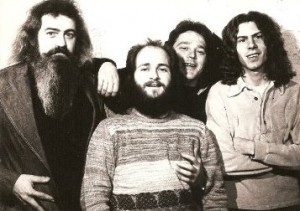
Electric Natchez Trace (L-R) Bob Riley, Ronn Burke, Dan Parsons, Bud Chrysler, c.1977
This new “electric” version of Natchez Trace gained increased exposure by appearing on WOOD-TV’s Buck Matthews Show and performing at a country music concert at Grand Valley State College’s field house on April 1, 1977. This show also featured Heartsfield and headliner John Hartford.
Soon after the show at Grand Valley, Natchez Trace disbanded. At that time, Ronn and Bob Vogel worked together for a second time when he joined Dirk Rivers. Ronn and Bob had sung together at the age of 10 in “The Combos,” at the beginning of the 1960s. Bob Vogel: “Ronn approached me and asked if he could join Dirk Rivers. We began playing at the Mouse Trap on Bridge Street. After a while we hired Dan Parsons, too, formerly with Natchez Trace.”
Bob and his brother Dick, a drummer, formed Dirk Rivers in early 1974 with guitarist Jerry Davis and Kim Rush on bass. This original version of Dirk Rivers was clearly a rock and roll band. They played in clubs and at dances in Michigan and at Park City, Illinois. They also performed at concerts held at the Thunderchicken on Alpine in 1975, backing up James Gang, T. Rex and Rory Gallagher. When they broke up that same summer, Bob and his brother Dick restrained themselves temporarily by creating a “lounge band” trio with bassist Mike Grattan, which they called The Vogel Brothers. This project lasted for about a year until they decided to revive the Dirk Rivers Band. This new edition included guitarist Rick Brown and Bob Reilly on bass.
On April 21, 1979, Dirk Rivers played at Bea Baker’s Alpine Lounge, a bar that this band worked at regularly. Members at that time were Bob and Dick Vogel, Danny Parsons, John Fritz and Ronn Burke.
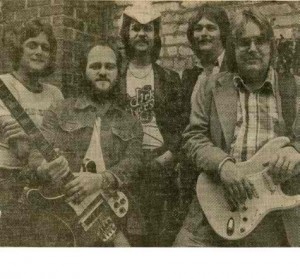
Dirk Rivers
In late 1979 and early 1980, Ronn and the Dirk Rivers Band backed up Rick Nelson, Tanya Tucker, Doug Kershaw and the Ozark Mountain Daredevils at Paulo’s Living Room on South Division and 54th Street. They also played a show with Johnny Paycheck at the Civic Auditorium.
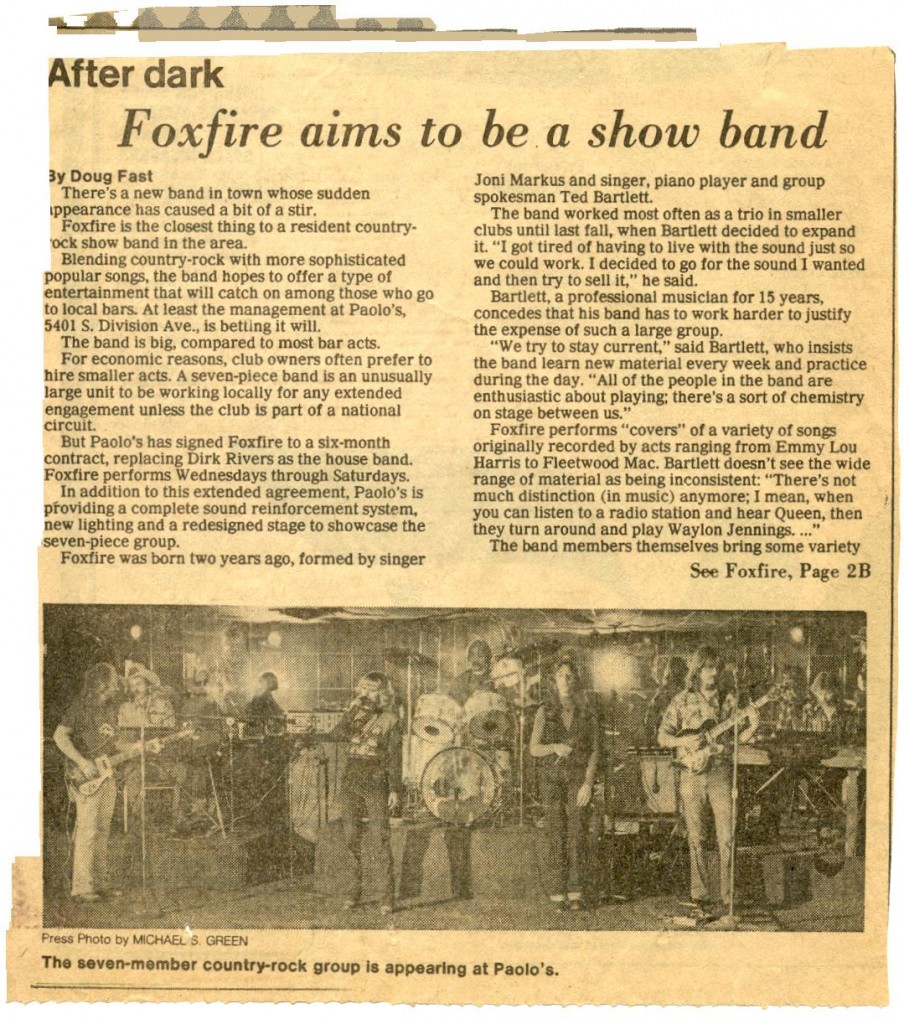
Ronn in Foxfire at Paulo's Living Room, courtesy Grand Rapids Press, c.1980
Ronn’s tenure with Dirk Rivers extended into 1984, other than a few months spent with a seven member country music “show band” named Foxfire in 1980. Burke replaced Doug Klein on bass when the group had already been working for a few months at Paulo’s Living Room. Veteran Grand Rapids musician Lin Nowicki (formerly with Lynn and the Invaders and Common People) sang for this band, as well as two other female singers, Patsy Stevens and Joannie Markus.
Probably the most significant part of Ronn’s involvement with Foxfire was the musical relationship that he created with guitarist/vocalist Steve Damstra. When Foxfire dismantled Ronn was certain that he wanted to continue working with Steve. Bob Vogel: “Dirk Rivers broke up shortly in 1980 and Ronn went with Foxfire. That band lasted about two seconds. When they broke up I asked Ronn to come back and he said he would if we also hired Steve Damstra. We did. That band won the local Wrangler Country Star Search at the Alibi (AKA Thunderchicken) on Alpine.” This was held in November and December of 1981, with fifty area bands competing. Initially, each of these bands played for either 15 minutes or 3 songs. The four best acts played five minutes each on December 6, 1981. The regional were held in Detroit. The national finals were held in April of 1982 in Nashville, Tennessee.
This incarnation of Dirk Rivers after Foxfire was a venture into country rock and “southern” rock music. But in 1983, while they were playing in Wisconsin, the band decided to change their musical format by covering current rock hits, though this was short lived.
In 1984 Steve and Ronn parted company with the Vogel brothers to revisit another acoustic guitar version of Natchez Trace with Kevin Radeke. Ronn Burke played bass guitar with this band. But this acoustic guitar format was not long lasting. In 1985, Tom Dever was added on drums, and they began to perform classic rock while retaining some of their lighter tunes. Steve Damstra recalls that during the Natchez Trace ‘rock band’ era, “we opened for Mitch Ryder and the Detroit Wheels, as well as Rare Earth.”
During the following year Kevin left Natchez Trace and was replaced by guitarist/vocalist John Andrews, formerly a fellow member of Horsefeather with Steve Damstra. This version of Natchez Trace became a “classic oldies” band, featuring cover versions of popular bands like the Beatles, Hollies and the Grassroots. They retained this style until 1995. Personnel changes during this phase included the departure of John Andrews, with Roger Matthews replacing him in 1988. Coincidentally, John returned in 1990 but left again in 1993 (replaced by Dave Clausen) and finally rejoined again in 1995 for the last three months of Natchez Trace as a rock band.
It is interesting to note that a DVD of a December 1988 Natchez Trace performance exists. In 1982 Doug Taylor, a Natchez Trace fan, bought a high quality Panasonic video camera and started video-taping bands that he liked. However, he was not satisfied with the lack of audio quality produced with the camera. While at a Natchez Trace performance, Doug asked Ronn Burke for permission to obtain quality recordings from their sound board as well as film the band in action.
Ronn consented and they set up the date to record at Russo’s Restaurant in Belding. Dickie Harris, their sound man, had worked for Ronnie Fray and many other local bands. Dickie mixed the audio perfectly that night, and the audio recording was given to Doug. Taylor did his best to film the performance, working around the dancers. Burke jokingly told the dancers to step on Doug if he got in their way. Doug succeeded in getting some good on-stage close-up shots of Natchez Trace as they performed that night, and he returned the following night to obtain additional footage.
Doug originally planned on editing the film and audio and presenting it to the band members as a finished product, but he maintained a hectic schedule designing and manufacturing pit-to- driver communications systems for professional auto racing teams across the country. Ronn and Steve Damstra kept asking Doug about the tapes, and Doug responded that the tapes were lost. After 21 years and a move to the Upper Peninsula in 2009, he found the tapes and proceeded to create a DVD product, which he presented to Ronn and Steve as a surprise gift. He called the DVD “The Natchez Trace Lost Tapes Album”. One song from this DVD can be found on You Tube at http://www.youtube.com/watch?v=q-dHoMQGQF8
In 1989 Ronn suffered a heart attack and spent some time recovering before returning to the band in 1990. Bob Vogel filled in on bass for one night so that Natchez Trace could honor a commitment. Stu Maynard was hired to play bass until Ronn was ready to come back. Stu left the band shortly after Ronn returned.
From 1995 to 1997, Natchez Trace again reverted to the acoustic guitar trio format. This version was known as “Natchez Trace Unplugged” and comprised of Ronn, Steve and newcomer guitarist/vocalist/ songwriter Max Morrison. Max was born in Shreveport, Louisiana in 1954, and moved to Grand Rapids in 1982. In addition to several other musical projects, Max had worked in Grand Rapids with singer Roberta Bradley for twelve years previous to joining Ronn and Steve. Max contends that during the years that he played with Ronn Burke, they never publicly performed the scores of songs that were composed by the band members.
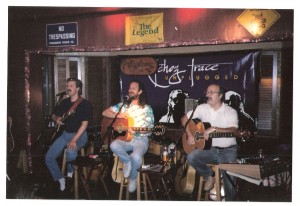
(L-R) Steve Damstra, Max Morrison, Ronn Burke
In 1996, the trio functioned as the opening act for The Grassroots at a well-attended outdoor concert in Muskegon called Skyrockin’ 96. It was sponsored by the Pyrotechnics Guild International.
In 1997, Natchez Trace broke up when Steve Damstra decided to leave to pursue a solo career. Max and Ronn still played a few gigs together until Ronn joined a new band called Icon.
In 1998 through 1999, another trio was created by Max, Ronn and Robin Spring. They called it Triad. Robin was born into a significantly musical family. Her great grandfather, paternal and maternal grandfathers, her mother and her uncle were all musicians.
While Ronn was playing with Icon, Robin and Max were working with Keith Ayers in a trio named Song Bird. Max had also played with Robin in a group named Carom with Tone VanLente in 1994 before he joined Steve Damstra and Ronn in Natchez Trace in 1995. In 1996, Robin and Max were working with Roberta Bradley in a group named Pandora.
Triad’s last performance was on New Year’s Eve in 1999 at the Old Boy’s Brew Pub in Spring Lake. Max was also busy working with Roberta Bradley and Dan Giacobassi at the time that Triad broke up.
In 2000, Robin and Ronn created a duet entitled R & R Music Co. Later they called themselves R & R- Ronn and Robin. Robin states that R & R also stood for “restful and relaxing,” as their music was delivered in an acoustic and easy-going style, while capitalizing on their vocal harmonies. Ronn and Robin promoted this duet until late 2005, when Steve Damstra joined them. Their first engagement as a trio was in early 2006, when once again, they adopted the name of Natchez Trace, but there music was also suitably described as, “Natchez Trace Acoustic Classic Rock.”
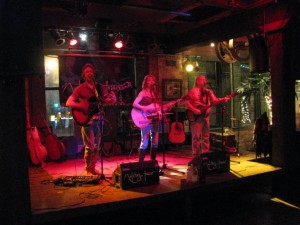
Steve Damstra, Robin Spring, Ronn Burke
They performed at major Grand Rapids events such as the 4th of July downtown firework displays, Celebration on the Grand, Festival of the Arts, Art Prize, and opened for Jonathan Edwards and Joe Piscopo performances at the B.O.B. They also played at the Muskegon Summer Celebration and the Lowell Showboat celebration, as well as a huge rally which supported the election of Jennifer Granholm.
This group thrived until May of 2011 when Ronn decided that he wanted to start performing on his own and devote more time to the writing and performing of his own compositions. Ronn is also currently working on a book project about his career in music.
Written by Kim Rush and Doug Taylor
Credits:
Part 1 compiled by Ronn and Amy Burke with Kim Rush; with assistance from Robin Nott, Paul Magnan, Buddy Chrysler, Bob Vogel, Doug Taylor and Bob Reilly.
Part 2 compiled by Ronn and Amy Burke, Robin Spring, Steve Damstra, Max Morrison, Doug Taylor, Kim Rush, Bob and Dick Vogel, Bob Reilly, Buddy Chysler and Lin Nowicki.
Credit to Chas Kit for his article about the Jujus from his “Garage Hangover “ website. See: http://www.garagehangover.com/?q=JuJus
Ronnie Burke will be at Cheer’s on Plainfield in Grand Rapids on September 22nd, 8:30 – 11:30

2 Responses to Save #2